4-21-15
Will It Snow for Christmas? Sandrine Veysset’s New Classic
By Diane Sippl
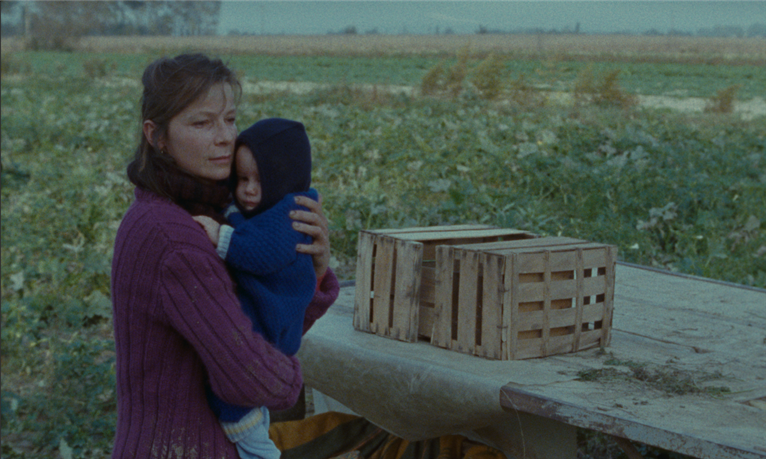
What was difficult in writing this story was to sort out memories and mix them with fiction. It is all that moves in the interior of your head that is difficult… I think I didn’t make this movie for others. I even did it against others. I wanted the film to relate to me.
Sandrine Veysset in an interview with filmmaker Claire Denis
Production Notes, Will It Snow for Christmas?
The 2015 COLCOA French Film Festival, April 20-28 at the Directors Guild of America in Los Angeles, boasts “9 days of premieres in Hollywood,” screening a record-breaking 68 films of which 3 are world premieres, 7 are international premieres, 14 are North American or U.S. premieres, and 16 are west coast premieres. The organizers are also proud to expand with a new competition for films and series produced for television, owing to the “evolution of the market, the industry, and film viewers’ habits” but also because American directors, writers, and distributors “are involved in both fields,” according to François Truffart, Executive Producer and Artistic Director of the annual event.
Known for nineteen years as “City of Lights, City of Angels,” COLCOA was launched in 1997 as a cultural exchange of cinema, then co-hosted by UCLA’s School of Theatre Arts, Department of Motion Pictures-Television, that allowed Americans to see the latest and the best of French films at our own doorstep. Showcasing well-known auteurs, new talent and debuts, and avant-garde works side-stepped by blockbuster venues and conventional programming, the prestigious gathering let its fans take for granted that so-called “art films” would fill the screens just as their directors, writers, and actors would dialogue with the audiences. More and more, it seems, it’s difficult to presume many of these attributes of an extravaganza that now calls itself “the largest French film festival in the world.”
That said, local filmgoers are in for a real treat with a tastefully programmed event heading off the “COLCOA Classics” segment of this year’s event on Tuesday at 2 pm — the free screening of a newly restored print of Will It Snow for Christmas?. It’s Sandrine Veysset’s debut feature, widely lauded at festivals when it first appeared in 1996 and already deemed a classic of French cinema.
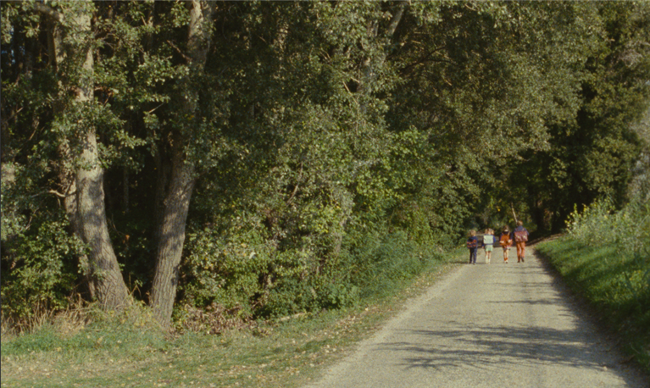
Set in the south of France near Avignon, Will It Snow for Christmas? draws from the childhood of its writer and director, Sandrine Veysset, and uses a uniquely cinematic language to build our experience of time on the screen. In this film time is presented as the cycle of nature in the countryside, a mute character emerging poetically as a child resistant to the constraints at-hand. Here they are a patriarchal order and its protocol. Nature (in the film as in life) has a proclivity to surprise rather than to recognize, bend, or conform. Its performance is ephemeral — it can be seen and felt, but never contained.
In her homage to motherhood, Veysset wanted to show a woman with very few choices in her life, including whether to bear children or not and how to feed, clothe, and shelter them. While the film transpires in an era prior to our own, it is also timeless to the extent that Veysset wasn’t interested in developing it as a period piece. Yet its internal time breathes with the rhythm of a heartbeat. Its editing contingent upon real time and its camera at the center of the action, Veysset’s film achieves a very physical relation to space and an equally visceral relation to the characters. Deliberately casting a then unknown actress in the key role with the premise of creating real life for a woman and seven children and then seizing those moments for the screen, Veysset observes, “I think there was often more ‘life’ than ‘film’ in the shooting.” Such performances, seemingly non-theatrical and even non-dramatic, gain texture and depth from the ways that the natural elements act upon a place over time — the ways that heat, wind, rain, and cold, expected though uncontrollable, and yet inevitably changing, transform people’s emotional outlooks. In her production notes, in an interview with Claire Denis, Veysset put it this way:
The seasons are an important character in the film. How a place changes as time passes. I liked this idea of transformation… especially of children who grow up very quickly. It was really very exciting to wonder how we were going to find them at each stage of the shooting... I enjoy very much all these changes that occurred without me, all those things that are uncontrollable and that transcend make-up or special effects.
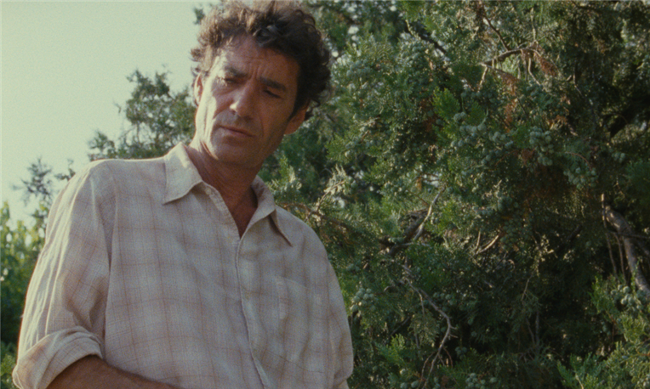
Will It Snow for Christmas? increasingly poses its lead character, the mother, in a state of mourning as she notes her loss of faith and hope in her lover, her loss of love from the father of her seven children, as he seeks his own comfort at their expense and resides in a nearby town with his wife and their own numerous children. While the mother on the farm lives in poverty and subjugation, she and her children are most concerned not with the absence of the man she mourns, but with his presence.
Their loss is mostly an emotional one: the children have a father; they just don’t want him. The “death” the woman experiences, of her lover and herself, takes place only at the symbolic level, and even their separation is only one of feeling. The tension in this feeling is between surface and depth, darkness and light, oppression and resilience, knowledge and hope. As time takes its toll, space prevails. By the very terms of her relation to her lover — that is, the strength of her labor and the support of her children — the woman has the house and the land, and what is interesting to see is how these spaces, hinging on the excesses of the characters’ performances, increasingly displace the father and structure his absence, even if only at the emotional core of the film. What fills the center, then, is the affective bond between the mother and the children that evolves as an active exchange.
The film opens by establishing the difference between the children’s and the father’s relations to the spaces of the farm. Theirs is horizontal; his is vertical. Characteristically, the first we see is theirs. The pre-credit sequence places us in the midst of a hide-and-seek game in a barn. The camera eye is our own as we run, dodging bales of hay, chasing shadows in the golden light. The exhilaration of finding each other is all that guides us. Chimes in the wind and a xylophone enhance the merriment, but it’s the last off-screen music we’ll hear until the end of the film. The sound cuts abruptly to the roar of a tractor engine on a dusty road and a point of view from the driver’s seat so high up we have the sense of God peering down on his creation. In no time this father attacks his son’s “laziness,” the mother defends the son at the family meal, the father strikes the mother, the eldest daughter comes between them, and the result is a separation in space: from the head of the table we look into the yard where the mother stands abreast of two daughters and casts a stone at the father through a barred window that frames those outside as captives.
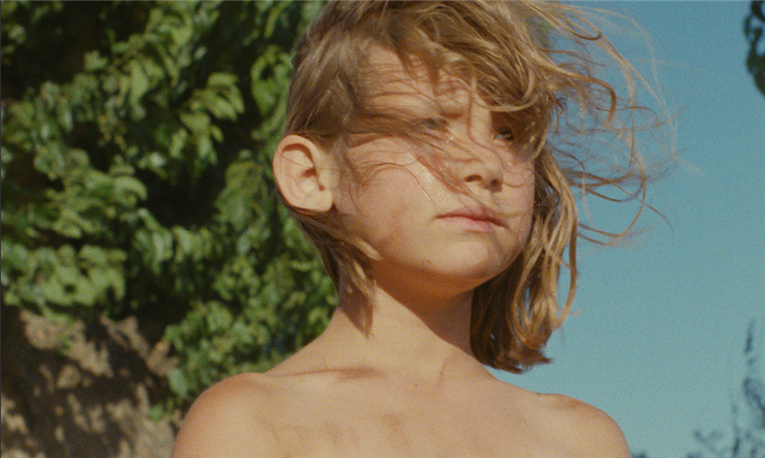
The images gain a poetic resonance through their juxtaposition and association. In one scene, fireworks fill the sky of a summer night as the children savor a distant celebration. In an autumn rain the camera moves from one to another smiling face when the smaller children make a game of walking to school in a caravan, lifting a long plastic field sheet over their heads for an improvised umbrella.
The peace, self-reliance, and good humor of these children would paint an idyllic picture of their life were it not for the preponderance of screen time spent on their relentless toil in the fields alongside their mother, overseen by the brutish father as he casts his self-contempt upon her and the children. He accuses the mother of rejecting him for someone else, tells her to take her brats and leave, and threatens that if she goes, he’ll bring harm to them all. Of course she hasn’t tried to leave and has no way of leaving, and he leaves her for the company of his marital family every time he comes; worse, what has precipitated the confrontation is his own pass at his own “illegitimate” daughter, a crisis that seals the mother’s despair. Her grief is visualized by her solitary figure in the expanse of the late autumn fields, save for the baby in her arms, symbolic of nature’s mute seasons, undeniable and irrevocable in the force of their presence. The frame wipes with black from its edges to the center for a brief cameo of the mother and child, the cameo itself then receding to blackness at the center.
On a night when the family TV is broken, the mother responds to a command performance of her dream as a sixteen-year-old. In fact, it’s the children’s creation story, of how they came to life as her punishment for “vanity” — what should be cross-read by them as their mother’s self-confidence but what God regarded as uppity arrogance. “It was in a cave full of light,” she begins. When a child asks, “What did he look like?” and the mother responds, “You can’t see God’s face…” we know the children find their pleasure in the allegorical aspect of the tale, the mean God an allusion to their come-and-go father.
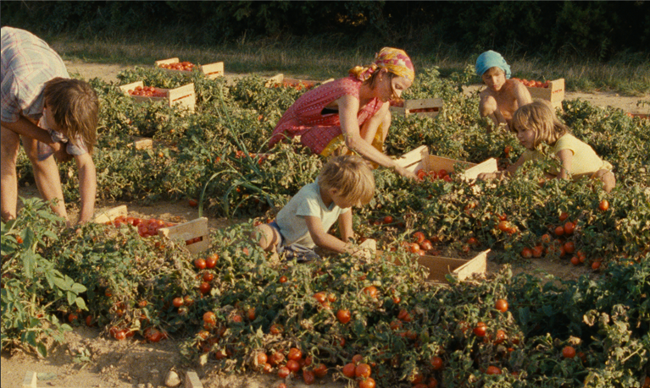
It’s worth a digression here to take stock of the approach to music in the film. In an interview with Claire Denis for the film’s production notes, Sandrine Veysset explained it this way:
At the beginning I did not know if there would be music or not. It happened gradually… During the shooting, I imagined the movie as a silent one. I said to myself that even if there were no words, one should be able to understand the story… As for the music, I thought it would smooth the rough edges, make the movie less tough… and I did not want that… to hide its awkwardness, its imperfections. I don’t like smooth things.
The film closes with an unforgettable scene that begins in silence and is incredibly visual. With the children’s point of view from below, outside as they play, they throw snowballs up at the mother’s window to draw her into their elation. As the camera moves closer to the mother, their gaze becomes ours, their snow and ice crashing and melting, sliding over her smile through the glass, pelts of snow like blows to her heart, dripping tears from her eyes as her face fills the window that is our screen.
A moment later, these “tears of snow” are accompanied by a woman’s off-screen voice bursting forth in a song, a song or mourning, magic, and despair. A “lover who shall not come” brings a “silken cortège of white tears, a frozen merry-go-round.” We sense the relation between silence and song, absence and presence, a woman’s solitude and her children’s active engagement of their mother. Such blows to the heart, as formless and ephemeral as snow, not only take on a voice — symbolically the mother’s song — but also present a tactile challenge to the images that dissipate in time, a magic to be experienced both within and beyond the codes for cinema.
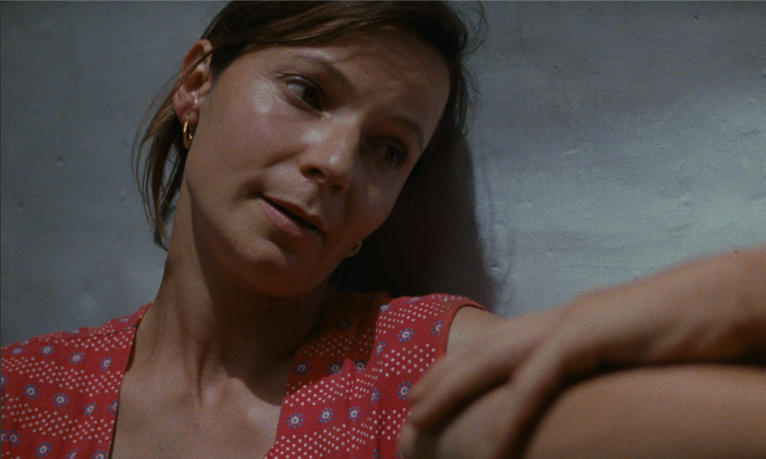
Will It Snow for Christmas?
Director: Sandrine Veysset; Producer: Humbert Balsan; Screenplay: Sandrine Veysset, Antoinette de Robien; Cinematographer: Hélène Louvart; Editor: Nelly Quettier; Music: Henri Ancillotti.
Cast: Dominique Reymond, Daniel Duval, Jessica Martinez, Alexandre Roger, Xavier Colonna.
Color, 35mm, 90 min. In French with English subtitles.